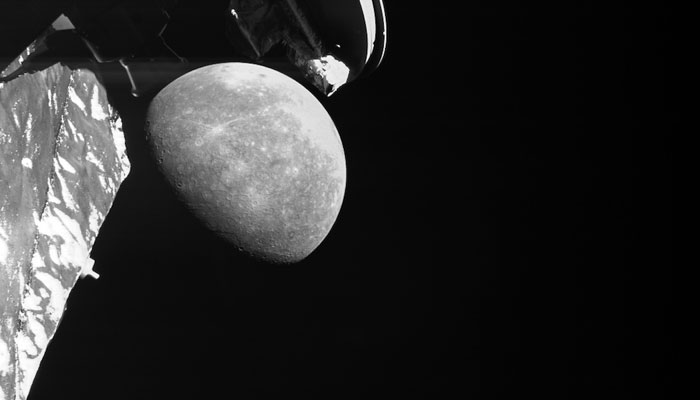European-Japanese space probe BepiColombo snaps Mercury
"While the next Mercury flyby isn't until September 2024, there are still challenges to tackle in the intervening time," says expert
June 21, 2023

Scientists have revealed new images of our solar system’s first planet — Mercury — captured by a joint European-Japanese space probe BepiColombo on its third gravity assist flyby Monday.
The pictures were snapped from about 236 km above, on the night side of the planet, showing a surface riddled with craters, including tectonic and volcanic curiosities as the space probe adjusts its trajectory for entering Mercury orbit in 2025, according to European Space Agency (ESA) website.
The space mission was launched in 2018 as it is near to concluding its seven-year stretch of the inner solar system.
"Everything went very smoothly with the flyby and images from the monitoring cameras taken during the close approach phase of the flyby have been transmitted to the ground," said Ignacio Clerigo, BepiColombo Spacecraft Operations Manager.
"While the next Mercury flyby isn't until September 2024, there are still challenges to tackle in the intervening time: our next long solar electric propulsion 'thruster arc' is planned to start early August until mid-September."
These pictures best as of yet will provide scientists with an opportunity to study more deeply about the planet and its evolution.
"In combination with the flybys, the thruster arcs are critical in helping BepiColombo brake against the enormous gravitational pull of the Sun before we can enter orbit around Mercury."
The pictures were captured in black-and-white with a resolution of 1024 x 1024 pixels, showing interesting geological features, notably, a large 218 km-wide impact crater, which has been named "Manley" after the Jamaican artist Edna Manley.
Professor David Rothery, a member of the BepiColombo MCAM imaging team, said: "It will clearly be of interest for BepiColombo scientists in the future because it has excavated dark ‘low reflectance material’ that may be remnants of Mercury’s early carbon-rich crust."
"In addition, the basin floor within its interior has been flooded by smooth lava, demonstrative of Mercury’s prolonged history of volcanic activity."
"Many nearby impact basins have been flooded by volcanic lavas, making this a fascinating region for follow-up studies by BepiColombo," noted ESA’s website.
“This is an incredible region for studying Mercury’s tectonic history," said Valentina Galluzzi of Italy’s National Institute for Astrophysics (INAF).
"Mercury’s heavily cratered surface records a 4.6 billion year history of asteroid and comet bombardment, which together with unique tectonic and volcanic curiosities will help scientists unlock the secrets of the planet’s place in Solar System evolution," said ESA research fellow and planetary scientist Jack Wright.









